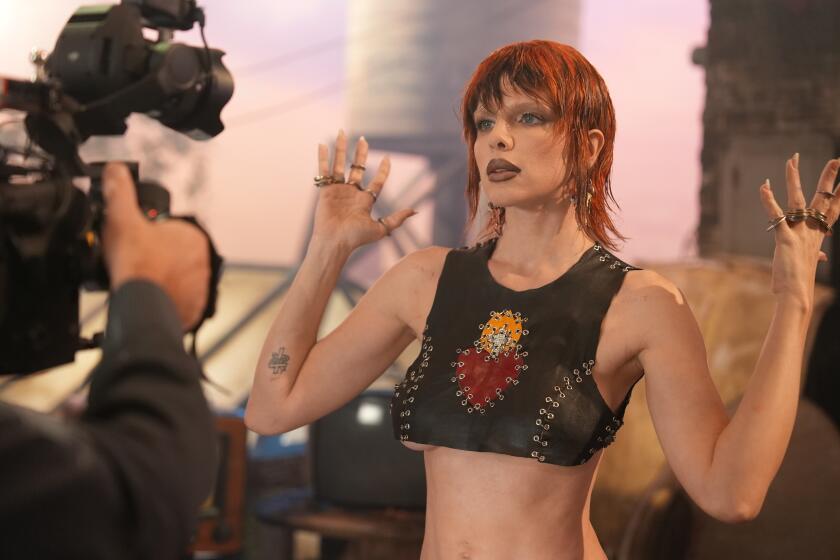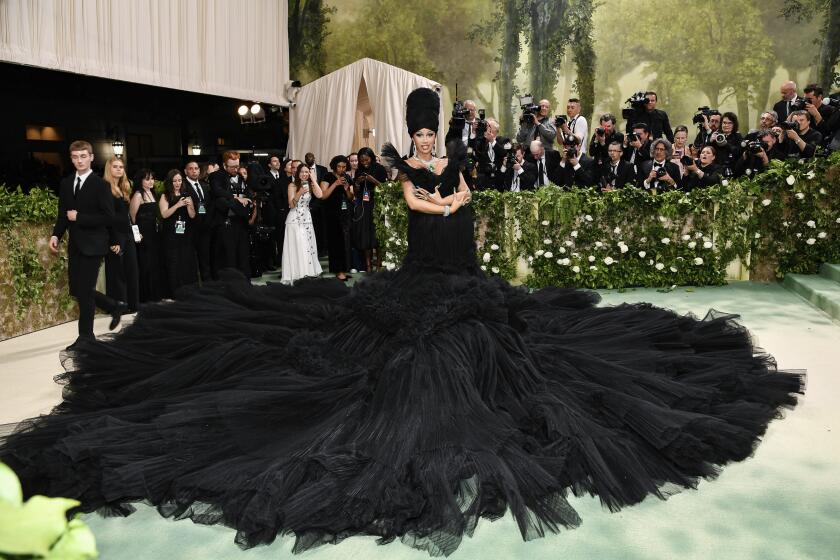Well, If You’ve Got It . . .
The bodacious men thundering across the stage have powerful, lumberjack shoulders and the whittled waists of elite swimmers. Their legs are gnarled by swollen quadriceps and coursing veins. Biceps flex with each move of their massive arms. Their clothes--skimpy though they are--cling to every hill and valley.
They are the male equivalent of the pinup girl.
The models revel in playing to an audience ravenous for something a little wicked. One young man’s hand teasingly slides along his inner thigh.
This recent spectacle, under cover of night in New York’s meat-packing district, is a fashion show staged by Tom of Finland Clothing. The appreciative audience is composed of fashion chroniclers, supportive friends and fans, and a few gentlemen who are getting lightheaded at the sight of so much bulging masculinity.
Fall ’97 will be the second season for Tom of Finland Clothing, designed by David Johnson and Gary Robinson and sold locally at a Tom of Finland store in Silver Lake and All-American Boy in West Hollywood. Beneath the cloud of testosterone is a collection of tight sportswear created for men who want to show off spectacular physiques. There is some camouflage, some polar fleece, some leather and lace-front pants. The silhouettes hug the body, the fabrics stretch, and the styles draw from the uniforms of police officers, outdoorsmen, mechanics and military men.
The clothes celebrate an ideal epitomized in the illustrations of Touko Laaksonen, better known as Tom of Finland, who died in 1991. For more than a generation of gay men, faced only with the stereotype of the foppish queen, the audacious drawings of Tom of Finland offered an alternative.
Tom’s men had the broad shoulders and tight waist associated with the male ideal. His men were so defined and sculpted that their bodies were like exaggerated, anatomically correct erotic dreams.
“As an artist, he glorified the male form,” Robinson says. “We spend so much of the time glorifying the female form, there’s nothing wrong with saying, ‘I work out. I want to show my body.’ And without going for that ‘60s peacock form.
“Men across the board can wear a great pair of jeans, a rain poncho or a well-cut vest,” Robinson says. “There’s nothing homoerotic about the clothes,” although he adds that some of Laaksonen’s drawings “were very erotic.”
The hyper-masculine style of some gay men--ranging from kitschy Village People cowboys and cops to leather daddies in motorcycle boots and jackets--can be traced to the imagery of Tom of Finland. The illustrator created a modern-day iconic gay style. And much of popular menswear owes a great debt to that gay aesthetic.
John Bartlett was inspired by the work of Tom of Finland when, about a year ago, he presented his influential runway show of buff models in tight-fitting clothes. Bartlett’s work, among several designers’, led to a shift from loose-fitting, boxy silhouettes to more close-to-the-body styles. Parisian Jean-Paul Gaultier’s beefy sailor boys and his macho behemoths in kilts reflect Tom of Finland’s aesthetic. And in more subtle ways, designers who emphasize a hyperbolic masculinity--such as Thierry Mugler, Raymond Dragon and the design team of Richard Edwards--owe a debt to Tom of Finland.
The artist was born in Finland in 1920 and started his career in advertising. Connections he made in that field led him to Los Angeles, where he concentrated on publishing. His first idealized male sketch was published in 1957, in a muscle magazine called Physique Pictorial.
Tom of Finland’s work was collected by Andy Warhol and Robert Mapplethorpe, and a biographical film, “Daddy and the Muscle Academy,” was financed by the Finnish government. The Tom of Finland Foundation was founded to preserve and promote erotic art.
In addition to drawings of Paul Bunyan types, Tom of Finland’s illustrations are filled with fetishistic references to cops, sailors, security guards and, more disturbingly, Nazis.
“In my drawings there is no politics, no ideological statements,” declares an entry in the retrospective catalog. “I am thinking only of the drawing itself. The whole Nazi ideology, the extremism, is hateful to me, but nevertheless I had to draw them--they had the sexiest uniforms!”
His illustrations have been used as examples of the ways in which fetishism infiltrates the general consciousness through fashion.
“As designers and as gay men, we’ve been sort of--not inundated --but [Tom’s work has] always been present in our lives,” Johnson says. “It’s something that pervades a designer’s work even if they aren’t doing a Tom of Finland line.”



